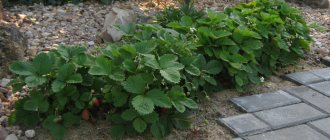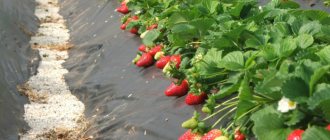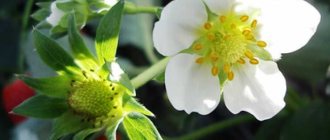Good day everyone! The gardening topic worries many today. Almost every second resident of our country owns a garden plot. And everyone strives to grow excellent crops on it.
We plant all sorts of crops at our dacha.
The main ones, of course, are vegetable crops. Almost everyone grows them. However, berry crops are also not forgotten, and everyone tries to plant at least a small bed of strawberries on their plot. After all, just as one cannot imagine a garden without tomatoes and cucumbers, one also cannot imagine it without this wonderful and tasty berry.
In this article we will talk about growing remontant berries. So what is a remontant?
Crops such as strawberries, wild strawberries, raspberries and some citrus fruits have the property of remontant. It means that these plants have the ability to bear fruit repeatedly or repeatedly during one growing season.
Varieties of remontant strawberry seeds
For many years now, strawberries have migrated from gardens and vegetable gardens to the window sills and loggias of ordinary apartments. Often at home they grow remontant garden strawberries, which are often called strawberries.
Remontability is the ability of a plant to bloom and bear fruit several times during the growing season. This way you can harvest from the beginning of summer until late autumn (until the first frost).
Today there are a large number of remontant varieties of strawberries on sale, so you can choose any one, relying on your taste preferences. It could be:
- large remontant hybrid strawberry (Scarlet Light, Sweet Tooth, Drop of Summer, etc.);
- “beardless” early ripening variety (Marmeladnaya, Alexandrina, Baron Solemacher, etc.);
- strawberries with berries of unusual color (hybrid - Golden Dessert, varieties - Snow White, Pineapple, etc.).
It is believed that the white variety of strawberries does not cause allergies, so this berry is given even to small children. Moreover, the vitamin composition is very similar to that of wild forest berries.
It is recommended to purchase seeds from trusted agricultural companies. There is another option - collecting seeds from the fruits of your own beds, but only after free pollination between several varieties will you be able to obtain a hybrid plant with special qualities.
Diseases and pests
The most common diseases of garden strawberries:
- Powdery mildew;
- Black rot;
- Gray and white rot;
- Root rot;
- Withering;
- Mottling;
- Mosaic.
Another problem is insects:
Aphid;
- Ants;
- Strawberry nematode;
- Pennitsa;
- Strawberry weevil;
- Spider mite;
- Slugs;
- Ants.
The best control measure is timely prevention.
It includes regularly replanting bushes and planting plants with an unpleasant odor for insects next to the beds. Severely affected plants are also removed to prevent the problem from spreading.
How to properly collect seeds and prepare the soil for seedlings?
You can collect seeds of remontant strawberries exclusively from varietal bushes, and not from hybrid plants, since this is the only way to preserve the maternal qualities of strawberries. You should proceed according to this scheme:
- Choose ripe berries by picking them from a productive bush. It is necessary that it fully corresponds to the variety.
- Remove the top layer of skin with seeds using a sharp knife. Place on a plate and wait until completely dry.
- It is best to place the plate in a sunny place with good ventilation - this will allow the berries to dry quickly and not rot.
- After a couple of days, you can collect the seeds and leave the pulp in the bowl.
Seeds of large remontant strawberries on a saucer
Seedlings of remontant strawberries are grown at home, but in extremely rare cases they do this in the garden. The seedlings appear very small and at the same time tender, so in open ground they can easily die.
For strawberry seedlings, it is recommended to use ready-made universal soil with a neutral pH, which can be purchased at a specialty store. Usually it does not contain pathogenic microflora, and the composition of such soil is quite acceptable for growing berries.
To prepare the soil yourself, you should mix the following components:
- 0.5 kg of turf soil;
- 0.25 kg sand;
- 0.25 kg of peat.
It’s also good to add a little vermicompost and wood ash to this composition. After mixing, the soil is sent to an oven preheated to 100 degrees and heated for 2-3 hours. This is necessary to destroy weed seeds and insect larvae. Such soil should then be left for 3 weeks, adding beneficial bacteria to it, using the drug Siyanie or Baikal EM1.
Preparing soil mixture for growing strawberry seedlings
The soil for germinating seeds must be prepared in advance; it must be calcined in the oven or spilled with potassium permanganate to destroy pathogens and possible pests.
More on the topic: Strawberries on the balcony in a pot
After treatment, the soil for strawberries should rest and recover for 2-3 weeks.
Before filling the containers, the earthen mixture must be sifted to make it more fluffy and airy.
The composition of the soil includes:
- Turf land – 50%.
- Peat – 25%.
- Sand – 25%.
You can also buy regular soil mixture for seedlings at a gardening store to grow strawberry seedlings.
Sowing seeds for seedlings and their germination
Strawberry seeds can be characterized by the fact that they germinate “tightly.” Manufacturers indicate the germination period on the bags - up to 1 month. This process can be accelerated by pre-soaking, stratifying or bubbling the seeds. What to choose is up to you.
Seed stratification
Stratification is the process of keeping seeds for a long time at low temperatures in a humid environment. This helps speed up their germination, since in nature the seeds first go through a period of sleep, and only then sprout. Stratification is carried out in February.
Seeds are sown on the surface of moist soil, and they are not sprinkled with earth on top (you cannot even sprinkle them a little, otherwise the seeds will not sprout). After this, cover the container with film and put it on a shelf in the refrigerator.
Many gardeners prefer another method of stratifying remontant strawberry seeds:
- Fill the container for seedlings with soil, compact it a little and slightly moisten it.
- Cover the soil with a centimeter layer of snow on top and press it down a little.
- Seeds are sown superficially (directly on the snow).
- Cover the container with plastic wrap and place it on the refrigerator shelf (temperature should be +2÷3 degrees).
- When the snow begins to melt, the seeds will go a little deeper into the soil. Additionally, they do not need to be covered with soil.
The container is allowed to be kept at a temperature of +2÷5 degrees for at least 14 days. Then you need to move the sowing to a warm place. Usually after this, shoots appear together.
Pre-soaking seeds
Remontant strawberry seeds collected or purchased in a store must be soaked in cold melt water for 72 hours. Be sure to change the water twice a day. During this period, the seeds swell, after which they need to be placed on a plate on damp paper towels, wrapped in a plastic bag or covered with glass, and sent to a warm place, remembering to ensure that the towels do not become dry. After the seeds hatch and the first true leaves appear, the plant should be planted in special peat pots.
Bubbling seeds
Sparging is another way to increase seed germination. This is a process that requires the seeds to be in warm water with air. To do this, lower the tube from the aquarium compressor into a liter jar with warm melt water. Place the seeds in a gauze bag or immediately pour them into a jar.
Then you need to turn on the compressor for 48 hours. It is very important that the water temperature is 25 degrees. After this procedure, you need to slightly dry the seeds and sow them.
Strawberry varieties for growing at home
It is advisable to choose remontant varieties that have an extended fruiting period. Otherwise, when planting ordinary summer species, the idea loses its meaning.
There are varieties that can be grown indoors in containers, on shelves or on windows. They are classified as self-pollinating. If plants are pollinated by insects, you will have to spend extra time pollinating with a brush.
Experienced gardeners recommend cultivating large- and small-fruited, bush (bearless) and hanging (climbing) varieties of strawberries. The most popular for growing at home are:
- Moscow Delicacy,
- Elizabeth II,
- Florian,
- Novel.
In conditions of good lighting, the required temperature conditions and with proper care, they produce crops all year round.
How to sow seeds in boxes?
You can sow strawberries both in peat tablets and in boxes. How the sowing process occurs:
- Take low boxes, fill them with prepared soil and compact them.
- Sow seeds on the surface of the soil. Do not cover the seeds with soil!
- Spray the seeds with a spray bottle.
- Cover the boxes with film.
- If the seeds have not been stratified before, you need to put the box in the refrigerator for 14-21 days. If the seeds have previously undergone “cold” processing, you need to put the boxes in a warm place.
When to sow remontant strawberries and how to care for them afterwards?
Remontant strawberries grown from seeds need at least 5 months before fruiting, so they need to be sown in February. Strawberries love sunny or partial shade. The optimal soil temperature for growing remontant strawberries is +20-25 degrees. If there are no favorable conditions, then it is better to plant strawberries in March or April.
Boxes with planted plants are kept in a warm place. Seeds can sprout both in the dark and in the light. It is necessary to check and ventilate greenhouses at least once a day, eliminating drops of condensation from the film. Depending on the seed manufacturer and pre-treatment, seedlings may appear in a month or a little earlier.
As for caring for seedlings, after the first shoots appear, the boxes should be moved to a well-lit place. It is not advisable to remove the film yet, since due to too dry air in the room, young shoots may die within a couple of hours. Therefore, it is recommended to use trays with transparent lids. You need to water the seedlings with a spray bottle, and you can already do it a little more abundantly.
Features of caring for adult remontant strawberries
Basic activities for caring for bushes:
- Regular loosening of the soil after planting to ensure oxygen reaches the roots.
- Frequent watering and in the required volumes, the soil should get wet by 2-3 cm, especially during the flowering period.
- Regular feeding 10-15 during the growing season.
- Protection against diseases and pest attacks.
- Regular weeding and removal of unnecessary tendrils, as well as reddening leaves.
The life of remontant bushes is quite short (on average 2-3 years), frequent fruiting quickly exhausts the plants and they die. Regular and proper care can significantly improve the quality of berries and increase the amount of harvest.
How to pick seedlings?
It is advisable to pick seedlings for the first time after the appearance of the first few true leaves. A week before this, it is necessary to ensure that the seedlings get used to indoor conditions and life without shelter. To do this, you need to slightly open the lid of the greenhouse, first for a few minutes, and then increase not only the time, but also the crack. So gradually you need to come to removing the cover. It is imperative to monitor the soil: it should not dry out, this will cause the death of the plants.
When the seeds germinate, the first two cotyledon leaves appear. As they develop, real leaves appear, and the cotyledons disappear. This period is called the “phase of 1-2 true leaves.” It is often written on seed packages that seedlings can be planted for the first time during this phase.
Transplant the picked seedlings into individual pots with a volume of 200-250 ml. It is better to take universal soil, but be sure to add 500 ml of vermicompost to it per 10 liters of substrate.
What to do next:
- Before picking, you need to water the box with seedlings well.
- Pull out each seedling using a thin stick (for example, a toothpick).
- Long roots need to be pinched so that the plant can form a powerful root system.
- Take a pot with prepared soil. Make a small depression in the soil, then place the strawberry roots in it so that they do not bend upward. The core of the plant should be above the ground.
- Water the planted plants with 20 ml of water and place them in a bright place, protected from the scorching rays of the sun.
The first days after picking, you need to carefully monitor the seedlings. If the room is dry and very hot, it is important to spray the leaves using warm water.
2 weeks after picking, you need to start feeding the plant. During this period, seedlings often grow actively, so it is recommended to use fertilizers that include nitrogen. Liquid, dry and water-soluble mineral fertilizers are suitable for these purposes. You need to fertilize the soil once a week.
What determines the timing of transplantation?
The time of work is chosen taking into account the genetic potential of the variety, its resistance to diseases and pests, the microclimate of the area, and care. Some varieties are depleted in 1-2 years, others in 5-6 years. Some day-neutral varieties, such as small-fruited alpine strawberries, develop very intensively. They need to be replanted after a year.
Bearless strawberry
Remontant strawberries need to be replanted in the spring, early summer before fruiting, or in the fall after harvesting. The optimal period for renewing strawberries is the end of August. Select the timing of the work yourself, taking into account the weather conditions of your region, the microclimate of the site, the presence of well-developed mustaches or strong bushes.
How to plant seedlings in open ground?
90-120 days after germination (i.e., when the first 6 true leaves appear), the seedlings can be planted in open ground. This must be done from mid-May or after the temperature during the day reaches 20 degrees and at night is at least 15 degrees. Before planting, be sure to harden the seedlings. Therefore, you need to take it out into the fresh air every day for 7 days, gradually increasing the time - from 30 minutes to 1.5 hours, and beyond.
If you don’t have time for this at all, you can put strawberry seedlings in a greenhouse or greenhouse. It is important that plants are hardened off, especially those grown without sunlight. When planting a previously unhardened plant in a garden bed, this can lead to the leaves simply scorching under the bright sun.
Technology of transplanting seedlings:
- Water the seedlings well before planting in open ground.
- Make holes in the prepared bed, maintaining a distance of 15-20 cm between plants and 25-30 cm between rows.
- Remove the seedling from the pot. When twisting the roots into a spiral, they should be carefully straightened, and those that are too long should be trimmed.
- Place an earthen ball with roots in the hole so that the core is at ground level.
- Flatten and water the soil around the strawberries.
Mulch the garden plant with chopped straw - this is necessary in order to avoid rapid evaporation of moisture and save the crop from destruction.
In the fall, you can move the remontant strawberries back into the house by transplanting them into spacious boxes. But this type of strawberry is able to bear fruit right up to the first frost, and then produce a harvest again the next year.
Features of care after sprouts appear
The appearance of sprouts is already half the battle, but the next stage is no less important. Young plantings need to be carefully looked after:
- After germination, do not immediately remove the lid or bag and expose it to the sun. Sprouts accustomed to the humid microclimate of a greenhouse can quickly dry out. The lid is gradually moved millimeter by millimeter; it should be exposed to the sun first for a couple of hours, gradually increasing the time.
- It is important to ensure that the young roots are covered with soil, otherwise the plants will die from drying out; as the sprouts grow, the plantings need to be sprinkled with soil mixture.
- Another problem during seed germination is mold. It must be carefully removed with a match, the seedlings must be ventilated and dried. Treat the soil mixture or peat with one of the antifungal drugs, according to the instructions for use.
- Condensation on the lid or film must be removed regularly; watering is done carefully at the root using a spoon; you can also water it in a tray.
- In April, you should begin hardening procedures. The container with seedlings can be taken out onto a glazed balcony, loggia or into a greenhouse. Immediately for a couple of hours, then you can leave it overnight; a slight decrease in night temperature promotes better hardening of strawberry seedlings.
- Then the slightly hardened seedlings are taken outside, first left in the shade, and then gradually brought out into the sun.
- You can plant it in a permanent place at the end of May or June.
- It is better to sacrifice the first harvest and pick off the flowers; the plants will have more time to form, become stronger for a successful winter and will give a more abundant harvest in the future.
Adult bushes also need constant attention from the gardener to obtain a tasty and abundant harvest.
More on the topic: Proper cultivation of strawberries in a greenhouse in winter
Proper care
The main care for strawberries before planting in open ground is the process of watering, fertilizing and spraying. You must adhere to certain rules:
- Occasionally you need to spray the seedlings with water from a spray bottle to maintain optimal humidity.
- It is undesirable to loosen the seedlings, since strawberries have a shallow root system - this can damage them.
- You need to water the plant carefully - the earthen ball should not be dry, but also too wet. It is necessary to pay attention to the condition of the soil. For example, seedlings that stand on a south window (under the rays of the sun) will dry out much more often than seedlings that stand under phytolamps in the back of the room.
To successfully grow remontant strawberries, you should not neglect the stratification of seeds and feeding of seedlings. Only by adhering to all the above recommendations will you be able to get healthy seedlings, strong strawberry seedlings and a good harvest.
0
0
Copy link
Carpet and row planting method
When choosing a method for planting remontant strawberries, you must first take into account the convenience of harvesting.
The carpet method assumes that the plants will be located at a distance of 20x20 cm from each other. Those. in the row there will be 20 cm between the bushes, and 20 cm between the rows. Over the years, the bush grows and fills the free space. For normal fruiting, 10–15 cm should remain between garden strawberry bushes. When growing using the carpet method, the soil will have to be fertilized every year in different ways.
The row method differs in that the distance between plants in a row is 20 - 25 cm, and between rows 70 cm. Usually, the free aisle is filled with young bushes that have taken root from the tendrils. But we have remontant strawberries, which means we have to rely on the fact that the bush will grow in diameter.
As a result of a simple analysis, it turns out that a carpet or solid method is suitable for planting strawberries of day-neutral varieties.
Planting technology:
- We dig holes at a distance of 20 - 25 cm from each other. You can use a small garden spatula. The depth of the hole is 10 - 15 cm. Focus on the length of the roots of the seedling you are going to plant. If you see that the root is voluminous and long, as it happened to me more than once, then make a larger hole so as not to injure the rhizome too much.
- We take out a strawberry/strawberry seedling from a container with a bump and lower it into the hole. We arrange several seedlings like this. One seedling for each hole.
Important! If the seedlings are small with short roots, you can plant two in one hole at once.
- Fill the hole with water and wait until it is absorbed. It is extremely important that the water draws the roots into the ground.
- Then fill the hole with soil. At the same time, we make sure that the root collar of the strawberry seedling is always on top or at soil level. We try not to bury it.
- We compact the soil around the root system.
- Water the bush again.
To water strawberry seedlings, you can use a solution of Fitosporin-M or other fertilizer.
The procedure is the same for all seedlings. Don't be alarmed if it turns out to be too much. Remember, at the beginning of the article I wondered how many strawberries my neighbor had that there were so many left? So, from my own experience, I was convinced that initially there might not have been much of it. After the transplant, my strawberry plantation grew considerably and increased 5-6 times. It's good that I had so much free land. But at the next transfer I will go with a big bucket to the neighbors.











